 |
Insect WaysTuesday 31st July 2001, West Yorkshire |
![]()
![]()
![]()
![]()
![]()
![]() This Month
Rocks
History
Workshop
Links
Home Page
This Month
Rocks
History
Workshop
Links
Home Page
![]()
 THE ORB WEB spider has a web-full of Hoverflies this morning. It's wrapping one of them in silk, while two are hanging, caught in the web.
THE ORB WEB spider has a web-full of Hoverflies this morning. It's wrapping one of them in silk, while two are hanging, caught in the web. You might remember the large tropical Moon Moth that turned up in a local garden on the 17th. These moths have no mouthparts and live for only two weeks or so. Here's an update from the people who found it; 'The moth you identified is still living on one of our Fuchsias, probably hanging on for a mate. She is looking a bit worn now, but we have grown quite attached to her.'
You might remember the large tropical Moon Moth that turned up in a local garden on the 17th. These moths have no mouthparts and live for only two weeks or so. Here's an update from the people who found it; 'The moth you identified is still living on one of our Fuchsias, probably hanging on for a mate. She is looking a bit worn now, but we have grown quite attached to her.' Equally exotic looking, but in fact common and native to Britain, are the bright orange-and-black striped Cinnabar Moth caterpillars which are eating the leaves of a Common Ragwort by the canal.
Equally exotic looking, but in fact common and native to Britain, are the bright orange-and-black striped Cinnabar Moth caterpillars which are eating the leaves of a Common Ragwort by the canal. In trimming back an unruly rose in the garden hedge I left one long shoot. There are two Robin's Pincushion Galls growing on it. The larvae of the small gall wasp Rhodites (AKA Diplolepsis or Cynips) rosae rosae develop inside this mossy, red and green gall. It is also known as Moss Gall or Bedeguar Gall. Bédé comes from a French word, meaning 'wind-brought'.
In trimming back an unruly rose in the garden hedge I left one long shoot. There are two Robin's Pincushion Galls growing on it. The larvae of the small gall wasp Rhodites (AKA Diplolepsis or Cynips) rosae rosae develop inside this mossy, red and green gall. It is also known as Moss Gall or Bedeguar Gall. Bédé comes from a French word, meaning 'wind-brought'.Peat-free v. home-made compost
 This Moneymaker tomato on the patio isn't doing as well as the one in the pot right next to it. Admittedly, it's growing in a smaller pot, but its lower leaves are turning yellow, so it's obvious that it's short of minerals, compared with the more vigourous, greener plant in the larger pot next to it. It is going to need extra feeding. The smaller pot contains a commercial peat-free compost while the larger pot is mainly filled with a compost I concocted from;
This Moneymaker tomato on the patio isn't doing as well as the one in the pot right next to it. Admittedly, it's growing in a smaller pot, but its lower leaves are turning yellow, so it's obvious that it's short of minerals, compared with the more vigourous, greener plant in the larger pot next to it. It is going to need extra feeding. The smaller pot contains a commercial peat-free compost while the larger pot is mainly filled with a compost I concocted from;- half a barrow of sieved garden compost
- half a barrow of good garden soil
- a sprinkling of organic-based fertiliser
The blood, fish and bone fertiliser that I used isn't entirely organic. When I read the small print, I discovered that it also contains a basic mix of essential plant nutrients.
One problem with my home-made compost is that after a while weeds seedlings start sprouting - the seeds are there in the soil. So I topped up the pot with the commercial peat-free compost, which acts as a mulch.
![]()
Richard Bell,
wildlife illustrator
E-mail; 'richard@willowisland.co.uk'
![]() Next page
Previous page
This day last year
This month
Nature Diary
Home Page
Next page
Previous page
This day last year
This month
Nature Diary
Home Page
![]()